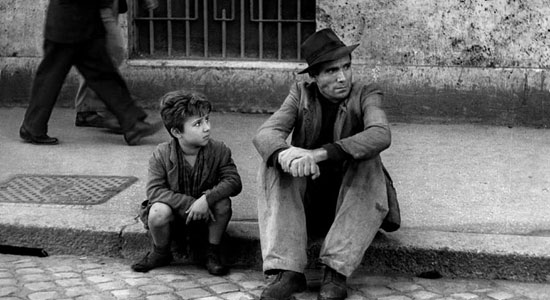MAGNET contributing editor Jud Cost is sharing some of the wealth of classic films he’s been lucky enough to see over the past 40 years. Trolling the backwaters of cinema, he has worked up a list of more than 100 titles—from the ’30s through the ’70s—that you may have missed. A new selection, all currently available on DVD, appears every Friday.

The Bicycle Thief (1948, in Italian with English subtitles, 93 minutes)
With the 1945 execution of repressive Fascist dictator Benito Mussolini, hung upside-down afterward in front of a gas station as proof that he was truly dead, Italy was ripe for a ruggedly honest new direction in cinema. Vittorio De Sica’s The Bicycle Thief, along with early works by Roberto Rossellini and Luchino Visconti, formed the foundation for a hard-hitting, anti-Hollywood movie style called neo-realism that accurately portrayed post-war poverty, was shot mostly on location in grainy black and white and employed many non-professional actors.
The Bicycle Thief (or Bicycle Thieves, as it’s now properly translated from the Italian) is just as touching a journey as the sad plight of immigrants riding the tops of boxcars north from Honduras through Mexico, sitting like stuffed animals in a shooting gallery in Cary Fukinaga’s chilling 2009 film Sin Nombre.
Antonio Ricci (Lamberto Maggiorani) can’t believe his good fortune when his application is chosen from a multitude of the unemployed, and he’s given a job plastering posters on the highways and back streets of Rome. The only pre-requisite is a bicycle, and Ricci’s has been pawned recently for cash to buy food for his family. But his wife, Maria (Lianella Carell) agrees to sell the cherished bed sheets from her dowry to redeem her husband’s two-wheeler. The next morning, after their young son Bruno (Enzo Staiola) has meticulously cleaned his dad’s bike, Maria sends the two of them out the door with fritatas wrapped in paper (a big one and a little one) stuffed in their shirt pockets.
Perched high on a wooden ladder while applying paste to an Ava Gardner poster, Antonio is horrified to see someone steal his bicycle. He dashes after the thief through the crowded streets with the fleeting image of his precious job vanishing before his eyes just as surely as his bicycle is disappearing around the next corner. The following day, Antonio, as chiseled and grim as Gary Cooper, and Bruno, his worshipful eyes cast upward toward his father, finally catch a glimpse of the thief and chase him into a nearby brothel.
With time running out to keep his job, Antonio visits a santona, part fortune-teller/part religious adviser, who informs him he’d better find the bike today or it will be too late. A good man near the end of his rope, Antonio stares down temptation of Biblical proportions as he paces back and forth outside a football stadium where hundreds of bicycles are parked, ripe for the taking.
The bittersweet soundtrack of The Bicycle Thief by Alessandro Cicognini, much like the provocative music from Raging Bull, is indebted to the romantic strains of the arias of Giacomo Puccini. It’s the one vibrant color spot here in a deliciously oppressive garden of grey.






